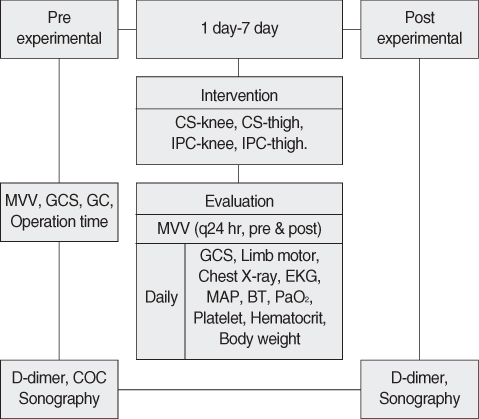J Korean Acad Nurs.
2009 Apr;39(2):288-297. 10.4040/jkan.2009.39.2.288.
Effects on Changes in Femoral Vein Blood Flow Velocity with the Use of Lower Extremity Compression for Critical Patients with Brain injury
- Affiliations
-
- 1Intensive Care Unit, Samsung Medical Center Concurrent Professor, Sungkyunkwan University Graduate School of Clinical Nursing Science, Seoul, Korea.
- 2Neurosurgical Intensive Care Unit, Samsung Medical Center, Seoul, Korea. monica1649@daum.net
- 3Vascular Lab, Samsung Medical Center, Seoul, Korea.
- KMID: 1405631
- DOI: http://doi.org/10.4040/jkan.2009.39.2.288
Abstract
- PURPOSE
This study was done to evaluate the mean venous velocity (MVV) response with knee and thigh length compression stockings (CS) versus intermittent pneumatic compression (IPC) devices in immobile patients with brain injuries. METHODS: We carried out a randomized controlled study. We analyzed both legs of a randomly chosen sample of 43 patients assigned to one of 4 groups (86 legs). The patients were sequentially hospitalized in the intensive care unit (ICU) in "S hospital" from November 2005 to December 2006. The base line and augmented venous velocity was measured at the level of the common femoral vein. We applied leg compression 42 times over 7 days (for 2 hours at a time at 2 hour intervals). RESULTS: There was a statistical difference among the 4 groups. The difference for the "IPC" group was more significant than the "CS" group. CONCLUSION: These results indicate that the application of IPC can be considered as an effective method to prevent deep vein thrombosis for immobile patients with brain injury.
MeSH Terms
Figure
Cited by 2 articles
-
Risk Factors Associated with Venous Thromboembolism in Cancer Patients
Su Jung Lee, Nam Cho Kim
Asian Oncol Nurs. 2015;15(3):171-177. doi: 10.5388/aon.2015.15.3.171.Risk Factors and Features of Critically Ill Patients with Deep Vein Thrombosis in Lower Extremities
Hwasoon Kim, Ok Min Cho, Hyo Im Cho, Ju Yeun Kim
J Korean Acad Nurs. 2012;42(3):396-404. doi: 10.4040/jkan.2012.42.3.396.
Reference
-
1. Ascher E, Depippo PS, Hingorani A, Yorkovich W, Salles-Cunha S. Does repeat duplex ultrasound for lower extremity deep vein thrombosis influence patient management? Vascular and Endovascular Surgery. 2004. 38:525–531.2. Byrne B. Deep vein thrombosis prophylaxis: The effectiveness and implications of using below-knee or thigh-length graduated compression stockings. Heart & Lung. 2001. 30:277–284.3. Choi JY, Park SJ. A comparison of interventions recorded in nursing notes between acute and subacute stage after a cerebrovascular accident. Journal of Korean Academy of Nursing. 2006. 36:227–235.4. Choi KS. A study of patients with head injuries. Journal of Korean Academy of Nursing. 1992. 22:517–528.5. Demolis P, Tran Dinh YR, Giudicelli JF. Relationships between cerebral regional blood flow velocities and volumetric blood flows and their respective reactivities to acetasolamide. Stroke. 1996. 27:1835–1839.6. Hameed MF, Browse DJ, Immelman EJ, Goldberg PA. Should knee-length replace thigh-length graduated compression stockings in the prevention of deep-vein thrombosis? South African Journal of Surgery. 2002. 40:15–16.7. Handoll HH, Farrar MJ, McBirnie J, Tytherleigh-Strong G, Milne AA, Gillespie WJ. Heparin, low molecular weight heparin and physical methods for preventing deep vein thrombosis and pulmonary embolism following surgery for hip fractures. Cochrane Database of Systematic Reviews. 2003. 2002, CD000305.8. John A, Heit M. Risk factor for venous thromboembolism. Clinics in Chest Medicine. 2003. 24:1–12.9. Jung DY, Kim Y, Kwon OY. Effect of deep breathing exercise and ankle exercise on blood flow velocity in the femoral vein. Journal of the Korean Academy of University Trained Physical Therapist. 2002. 9:107–113.10. Keith SL, McLaughlin DJ, Anderson FA Jr, Cardullo PA, Jones CE, Rohrer MJ, et al. Do graduated compression stockings and pneumatic boots have and additive effect on the peak velocity of venous blood flow? Archives of Surgery. 1992. 127:727–730.11. Kim YS. Effects of the application of elastic compression stockings on edema and pain of lower extremities in hospital nurses. 2005. Daegu: KeiMyung University;Unpublished master's thesis.12. Kurtoglu M, Yanar H, Bilsel Y, Guloglu R, Kizilirmak S, Buyukkurt D, et al. Venous thromboembolism prophylaxis after head and spinal trauma: Intermittent pneumatic compression devices versus low molecular weight heparin. World Journal of Surgery. 2004. 28:807–811.13. Kyrle PA, Eichinger S. Deep vein thrombosis. Lancet. 2005. 365:1163–1174.14. Lacut K, Bressollette L, Le Gal G, Etienne E, De Tinteniac A, Renault A, et al. Prevention of venous thrombosis in patients with acute intracerebral hemorrhage. Neurology. 2005. 65:865–869.15. Lee SH, Kim KT. Clinical application of compression treatment. Journal of the Korean Society of Phlebology. 2004. 3:25–28.16. Oh J, Yoon CM. Lower extremity edema and pain of nurses and the effect of self leg massage. Journal of Korean Academy of Nursing. 2008. 38:278–286.17. Phillips L, Macmillan A, Tweed C. Review of intermittent pneumatic compression: An evidence-based therapeutic modality for the prevention of avoidable deep vein thrombosis. Journal of Integrated Care Pathways. 2004. 8:55–58.18. The Standards Task Force of the American Society of Colon and Rectal Surgeons. Practice parameters for the prevention of venous thromboembolism. Diseases of the Colon & Rectum. 2002. 43:1037–1047.19. Van Blerk D. Evaluating an intermittent compression system for thromboembolism prophylaxis. Professional Nurse. 2004. 20(4):48–49.20. Yablon SA, Rock WA Jr, Nick TG, Sherer M, McGrath CM, Goodson KH. Deep vein thrombosis: Prevalence and risk factors in rehabilitation admissions with brain injury. Neurology. 2004. 63:485–491.
- Full Text Links
- Actions
-
Cited
- CITED
-
- Close
- Share
- Similar articles
-
- An Isolated Femoral Artery Aneurysm Presenting with Leg Swelling
- Improvement of the Femoral Venous Flow after Passive Exercise of the Paralytic Lower Limb in Stroke Patients
- A doppler study of blood flow change of lower limb arteries after transfemoral angiography
- Femoral Vessels Compression Caused by Iliopsoas Bursitis
- Measurements of Lower Extremity Blood Flow in Hemiplegic Patients by Doppler Ultrasound


